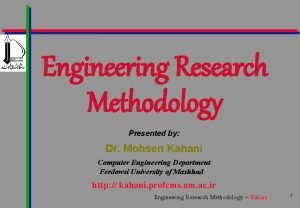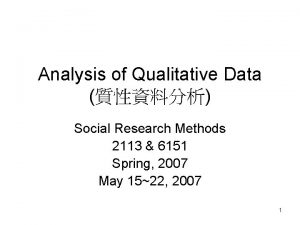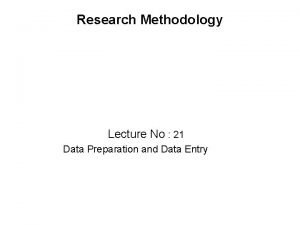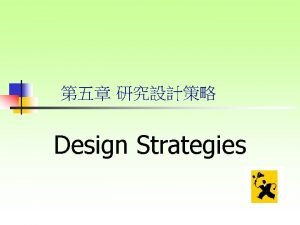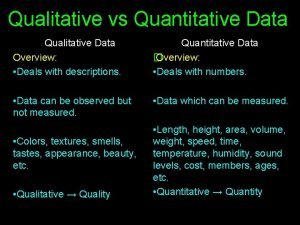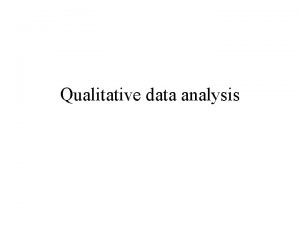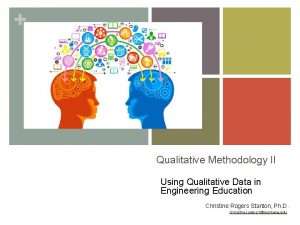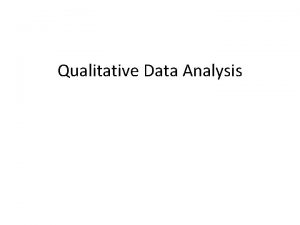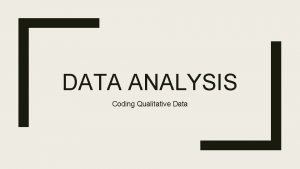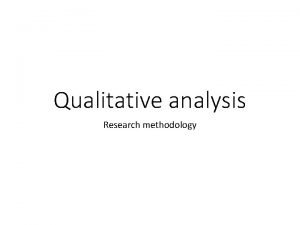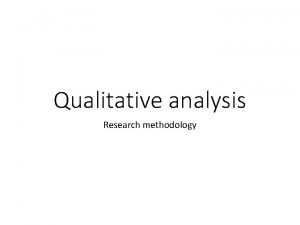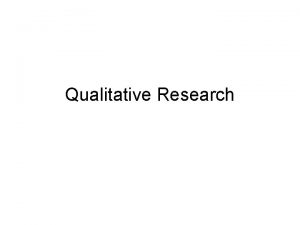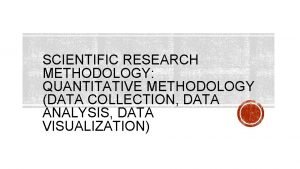Qualitative Methodology II Using Qualitative Data in Engineering





















- Slides: 21

+ Qualitative Methodology II Using Qualitative Data in Engineering Education Christine Rogers Stanton, Ph. D. christine. rogers 1@montana. edu

+ Qualitative Design Report results Analyze data Identify problem, purpose, & question(s) Select methodology & methods

+ Overview & Objectives n Explore areas of theory relevant to analysis of qualitative data n Practice analyzing data n Highlight opportunities for rigorous & innovative qualitative research in engineering education n Discuss recommendations for publication, grant proposal preparation, & presentation

+ What is Qualitative Research? Quantitative Qualitative Purpose WHAT is happening? Goal is to quantify results & generalize to larger population WHY is this happening? Goal is to gain deeper understanding of social phenomena Sample Large sample (generalizable) Small # of participants, cases, etc. (not typically generalizable) Data Focused on numerical Focused on observational & data (e. g. surveys, linguistic data (e. g. assessment scores, etc. ) observations, interviews) Analysis Statistical, Linear, & Positivist Interpretive, Iterative, & Theory-Driven

+ Theory n Pragmatism (“truth” depends upon practical outcome) n Constructivism (“truth” is socially constructed) n n Situated Learning Theory n Activity Theory Critical Theory (“truth” is shaped by power structures) n Feminism n Critical Indigenous Research

+ Situated Learning Theory n Zone of Proximal Development (Vygotsky) n “Legitimate peripheral participation” n Newcomers & old timers n Communities of practice n Apprenticeship/Teaching http: //neamathisi. com/new-learning/chapter-6 -the-nature-oflearning/lave-and-wenger-on-situated-learning

+ Feminism n “…as Borrego (2007 a) and Koro-Ljungberg and Douglas (2008) have demonstrated, much engineering education scholarship is still characterized by a lack of explicit and consistent theoretical engagement. Specific to research on women in engineering, Jawitz and Case argue that ‘feminist perspectives have much to offer in providing an explanation of women’s experiences in engineering and the resistance of the status quo to substantial change’ (2002, p. 390), and Nelson and Pawley recommend the inclusion and testing of more gender theories in engineering education research (2010). ” (Beddoes et al, 2011)

+ Data Sources n Interviews n n Structured, Un-Structured, Semi-Structured In-depth Individual, Focus Group Observations n n Field Notes Recording (audio and/or video) Journaling & Memoing Think-Aloud or Stimulated Recall n Content n Artifacts STANDOUT TIP: Go beyond single interviews or observations

+ Analysis n Revisit problem, purpose, & research question(s) n Develop a systematic process n Step 1: Open Coding (review data, line by line, identify descriptions) n Step 2: Organize & Categorize Codes (synthesize open codes, look for similarities & differences, note frequency & magnitude) n Step 3: Focused Coding (refine codes/categories, connect to theory/research literature) n Emergent Themes (throughout process) n Constant Comparative Analysis (seek patterns & “saturation”)

+ JEE Example: Focused Codes

+ Interviews: Example References childhood Personal Motivation “Growing up, I always wanted to make things, but all of my friends wanted to play with Barbies. It wasn’t a ‘girlie’ thing to do to actually do something. ” Peer/Social norms (Ann) “Doing” isn’t for girls

+ Interviews: Practice

+ Observation: Example

+ Observations: Practice Time/Location & Observed Data Analysis, Memo

+ Content: Examples n Draw an engineer

+ “Engineer” (First 4 Google Images)

+ “Engineer” (next 4 Google images)

+ Content: Practice n Your drawings

+Grants, Presentations, & Publications n Apply theory with integrity (especially critical theory) n Use diverse & robust data sources n Develop & describe systematic analysis procedures (codebooks? ) n Include examples (not just summaries, frequencies, etc. ) from data n Expand trustworthiness through member checks, multiple researchers, etc. n Create research teams with expertise in research methodology & teaching pedagogy n Read examples of quality qualitative and educational research (AERA journals, Qualitative Inquiry, & Qualitative Research) n Others?

+ Suggested Resources n Bazeley, P. (2009). Analysing qualitative data: More than ‘identifying themes, ’ The Malaysian Journal of Qualitative Research, 2, 1 -18. n Creswell, J. W. (2013). Qualitative inquiry & research design: Choosing among five approaches (3 rd ed. ). Thousand Oaks, CA: SAGE Publications. n Daly, S. , Mc. Gowan, A. , & Papalambros, P. (2013). Using qualitative research methods in engineering design research. Paper presented at International Conference on Engineering Design, Seoul, Korea. Available at: https: //m. designsociety. org/downloadpublication/34891/using_qualitative_research_methods_in_engineering_design_res earch n Hewitt-Taylor J (2001) Use of constant comparative analysis in qualitative research. Nursing Standard. 15, 42, 39 -42. Date of acceptance: March 19 2001. n Koro-Ljungberg, M. & Douglas, E. P. (2008). State of qualitative research in engineering education: Meta-Analysis of JEE articles 2005 -2006. Journal of Engineering Education, 97(2), 163 -175. n Lave, J. & Wenger, E. (1991). Situated learning: Legitimate peripheral participation. Cambridge, UK: Cambridge University Press.

+ Suggested Resources, cont. n Maxwell, J. A. (2013). Qualitative research design: An interactive approach (3 rd ed. ). Applied social science research methods series (Vol. 41). Thousand Oaks, CA: SAGE Publications. n Merriam, S. B. , & Tisdell, E. J. (2015). Qualitative research: A guide to design and implementation (4 th ed. ). San Francisco, CA: Jossey-Bass. n Miles, M. B. , Huberman, A. M. , & Saldan a, J. (2014). Qualitative data analysis: A methods sourcebook (3 rd ed. ). Thousand Oaks, CA: SAGE Publications. n Patton, M. Q. (2015). Qualitative research & evaluation methods (4 th ed. ). Thousand Oaks, CA: SAGE. n Saldana, J. (2012). The coding manual for qualitative researchers. Thousand Oaks, CA: SAGE. Summary available at: http: //salmapatel. co. uk/academia/coding-qualitativeresearch n Savin-Baden, M. , & Major, C. H. (2013). Chapter 5: Personal stance positionality and reflexivity. Qualitative Research: The Essential Guide to Theory and Practice. London: Routledge. n Van Note Chismm, N. , Douglas, E. , & Hilson, W. J. (2008). Qualitative research basics: A guide for engineering educators. Rigorous Research in Engineering Education, NSF. Available at: https: //crlte. engin. umich. edu/wp-content/uploads/sites/7/2013/06/Chism. Douglas-Hilson-Qualitative-Research-Basics-A-Guide-for-Engineering-Educators. pdf
 Chapter 3 quantitative research parts
Chapter 3 quantitative research parts Engineering research methods
Engineering research methods Data analysis qualitative and quantitative
Data analysis qualitative and quantitative Data
Data Data preparation process in research methodology
Data preparation process in research methodology Data center consolidation risks
Data center consolidation risks Research design
Research design Using system.collections
Using system.collections Defrost using internal heat is accomplished using
Defrost using internal heat is accomplished using System architecture example
System architecture example Forward engineering and reverse engineering
Forward engineering and reverse engineering Principles of complex systems for systems engineering
Principles of complex systems for systems engineering Engineering elegant systems: theory of systems engineering
Engineering elegant systems: theory of systems engineering Reverse engineering vs forward engineering
Reverse engineering vs forward engineering Is a bipolar survey qualitative or quantitative
Is a bipolar survey qualitative or quantitative Ualitative
Ualitative Quantitative measurement examples
Quantitative measurement examples Qualitative vs quantitative
Qualitative vs quantitative Qualitative data biology
Qualitative data biology Power bi for qualitative data
Power bi for qualitative data Principles of qualitative data analysis
Principles of qualitative data analysis Deductive coding
Deductive coding

